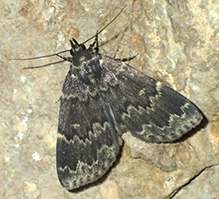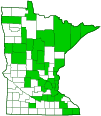glossy black idia moth
(Idia lubricalis)
Conservation • Description • Habitat • Ecology • Distribution • Taxonomy
|
||||||||
| Hodges # | 8334 |
|||||||
Conservation Status |
||||||||
| IUCN Red List | not listed |
|||||||
| NatureServe | NNR - Unranked SNR - Unranked |
|||||||
| Minnesota | not listed |
|||||||
Description |
||
Glossy black idia moth is a common, small to medium-sized, litter moth. It occurs throughout the United States, but it is rare in the northwest quarter of the country. It also occurs across southern Canada. It is common in Minnesota. Glossy black idia larvae feed on lichens, fungi, rotting wood, and other decaying organic matter. When feeding on decaying organic matter, they are probably getting most of their nourishment from fungi. Adults are found from late June to September in deciduous woodlands and shrubby areas. They are active at night and will come to lights. They also come to sugar baits painted on tree trunks. During the day they congregate in large numbers in hollowed out trees and sometimes in basements. Adults are 11⁄16″ to 13⁄16″ (18 to 21 mm) in length and have a 1″ to 1⅜″ (25 to 35 mm) wingspan. Some specimens are much smaller. Moths in the west are larger and paler, and they have more diffuse black markings. These size and color differences, and DNA barcoding, suggest that Idia lubricalis may be a complex of three or more species. The sensory mouthparts (labial palps) are long and upwardly curved, sickle shaped, reaching to the top of the head. The third segment is very flat, bladelike. On the male, the antennae are heavily covered with hair-like projections (cilia) and are also heavily bristled. The bristles are longer than the antennal segment to which they are attached. On the female, the antennae are lightly bristled. The forewings are broadly rounded on the outer margin. They are mostly dark blackish brown and glossy, with pale clay-colored markings. This is the feature that gives the moth its common name. They are crossed by three pale, sharply toothed lines. The antemedial (AM) line is shadowed below with black. The postmedial (PM) and subterminal (ST) lines are shadowed above with black. The area beyond the ST line is usually paler. The round spot in the upper median area (orbicular spot) is reduced to a small pale dot and is sometimes missing. The kidney-shaped spot (reniform spot) in the lower median area is pale and usually has a black, crescent-shaped mark in the middle. The black mark often nearly fills the reniform spot, leaving only a slender pale crescent on its upper edge. The hindwings are much paler and are crossed with the same lines, but the lines are broader and more diffuse. |
||
Size |
||
Total length: 11⁄16″ to 13⁄16″ (18 to 21 mm) Wingspan: 1″ to 1⅜″ (25 to 35 mm) |
||
Similar Species |
||
Habitat |
||
Deciduous woodlands and shrubby areas |
||
Ecology |
||
Season |
||
One generation per year: late June to September |
||
Behavior |
||
Adults are active at night and will come to lights. During the |
||
Life Cycle |
||
Caterpillars overwinter |
||
Larva Food |
||
Lichens, fungi, rotting wood, and other decaying organic matter |
||
Adult Food |
||
Flower nectar |
||
Distribution |
||||
|
Sources |
|||
| 12/10/2023 | ||||
Occurrence |
||||
Common |
||||
Taxonomy |
|||
Order |
Lepidoptera (Butterflies and Moths) | ||
Superfamily |
Noctuoidea (Owlet Moths and Allies) | ||
Family |
Erebidae (Underwing, Tiger, Tussock, and Allied Moths) | ||
Subfamily |
Herminiinae (litter moths) | ||
Genus |
Idia | ||
Until recently, the subfamily Herminiinae was treated either as the separate family Herminiidae or as a subfamily of Noctuidae. A molecular phylogenetic analysis of the family Erebidae (Zahiri, Reza; et al., 2011) determined that Herminiinae are closely related to Aganainae, which is a subfamily of Erebidae, and Herminiinae was moved as a whole to Erebidae. |
|||
Subordinate Taxa |
|||
Idia occidentalis was formerly treated as a subspecies of Idia lubricalis. |
|||
Synonyms |
|||
Bleptina surrectalis Camptylochila bistrigalis Epizeuxis cobeta Epizeuxis intensalis Epizeuxis lubricalis Helia phaealis Idia intensinalis |
|||
Common Names |
|||
glossy black idia glossy black idia moth |
|||
Glossary
Antemedial (AM) line
A thin line separating the basal area and the median area of the forewing of Lepidoptera.
Orbicular spot
A circular spot or outline in the upper median area near the antemedial line on the forewing of many moths.
Palp
Short for pedipalp. A segmented, finger-like process of an arthropod; one is attached to each maxilla and two are attached to the labium. They function as sense organs in spiders and insects, and as weapons in scorpions. Plural: palpi or palps.
Postmedial (PM) line
A thin line separating the median area and the postmedial area of the forewing of Lepidoptera.
Reniform spot
A kidney-shaped spot or outline in the lower median area near the PM line on the forewing of many moths.
Visitor Photos |
|||||
Share your photo of this insect. |
|||||
| This button not working for you? Simply email us at info@MinnesotaSeasons.com. Attach one or more photos and, if you like, a caption. |
|||||
Babette Kis |
|||||
Idia lubricalis glossy black idia moth Idia lubricalis, glossy black idia moth, photographed on stones at the house adjacent to Barnes Prairie, Racine Co., WI on June 25, 2022. These litter moths seem to be active during the early evening. |
 |
||||
MinnesotaSeasons.com Photos |
|||||
|
|||||

Visitor Videos |
|||
Share your video of this insect. |
|||
| This button not working for you? Simply email us at info@MinnesotaSeasons.com. Attach a video, a YouTube link, or a cloud storage link. |
|||
Other Videos |
|||
| Glossy Black India Moth Lori Jackson |
|||
About
Jul 20, 2021 idea lubricalis🤓 |
|||


Created: 12/10/2023
Last Updated:



